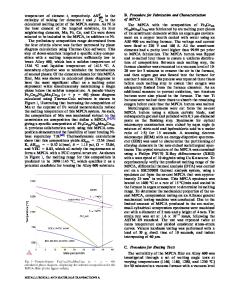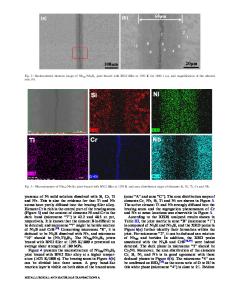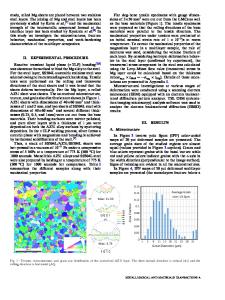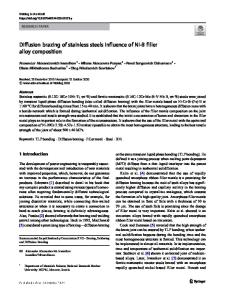Microstructure and Mechanical Properties of Stainless Steel/Brass Joints Brazed by Sn-Electroplated Ag Brazing Filler Me
- PDF / 1,737,212 Bytes
- 6 Pages / 593.972 x 792 pts Page_size
- 32 Downloads / 402 Views
JMEPEG https://doi.org/10.1007/s11665-018-3321-y
Microstructure and Mechanical Properties of Stainless Steel/Brass Joints Brazed by Sn-Electroplated Ag Brazing Filler Metals Xingxing Wang, Jin Peng, and Datian Cui (Submitted June 26, 2017; in revised form December 12, 2017) To develop a high-Sn-content AgCuZnSn brazing filler metal, the BAg50CuZn was used as the base filler metal and a Sn layer was electroplated upon it. Then, the 304 stainless steel and the H62 brass were induction-brazed with the Sn-plated brazing filler metals. The microstructures of the joints were examined with an optical microscope, a scanning electron microscope and an x-ray diffractometer. The corresponding mechanical properties were obtained with a universal tensile testing machine. The results indicated that the induction brazed joints consisted of the Ag phase, the Cu phase and the CuZn phase. When the content of Sn in the Sn-plated Ag brazing filler metal was 6.0 or 7.2 wt.%, the Cu5Zn8, the Cu41Sn11 and the Ag3Sn phases appeared in the brazed joint. The tensile strength of the joints brazed with the Sn-plated filler metal was higher compared to the joints with the base filler metal. When the content of Sn was 6.0 wt.%, the highest tensile strength of the joint reached to 395 MPa. The joint fractures presented a brittle mode, mixed with a low amount of ductile fracture, when the content of Sn exceeded 6.0 wt.%. Keywords
dissimilar joint, induction brazing, microstructure, silver-based filler metal, Sn coating, tensile strength
1. Introduction Energy conservation and low-carbon environment protection are important trends in the refrigeration industries (Ref 1). The brazed joints of dissimilar alloys such as stainless steels and brass are widely used in refrigeration, air conditioning and other manufacturing industries (Ref 2), especially in the refrigeration controls components and refrigeration pipes (Ref 3-6). Induction brazing is a rapid heating technique performed under a non-contact state and has the advantages of being environmentally benign and efficient (Ref 7, 8). This type of brazing is widely used to join stainless steel and brass. The brazed joints of 0Cr18Ni9 stainless steel tubes and H62 brass valves are obtained through high-frequency induction brazing (Ref 9, 10). The AgCuZnSn filler metals are widely applied in the brazing of stainless steel and brass, due to good wettability and filling ability. Additionally, many investigations have been made in the comprehensive performance improvement in AgCuZnSn filler metals through the additions of trace elements. In certain investigations, it was discovered that the addition of Ga (Ref 11, 12), In (Ref 13), Ni (Ref 14, 15), Mn (Ref 16) and La (Ref 17) has positive effects on the brazing properties of
Xingxing Wang, Jin Peng, and Datian Cui, School of Mechanical Engineering, North China University of Water Resources and Electric Power, Zhengzhou 450045, China. Contact e-mail: [email protected].
Journal of Materials Engineering and Performance
filler metals. In previous investigations of
Data Loading...











